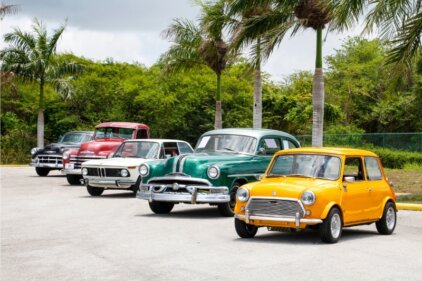As an automotive enthusiast, I have always been fascinated by the evolution of car designs throughout history. One particular design that has caught my attention is the Polonaise car design. Originating from Poland, the Polonaise car design has undergone a profound transformation over the years, transitioning from classic to contemporary styles. In this article, I will take you on a journey through time, tracing the evolution of Polonaise car designs and exploring the characteristics that define each era.
Classic Polonaise Car Designs
The classic Polonaise car designs evoke a sense of elegance and sophistication. These designs were prominent during the mid-20th century and are characterized by their sleek lines, curved fenders, and chrome accents. The classic Polonaise car designs were a reflection of the artistic influences of the time, with elements of Art Deco and Streamline Moderne styles.
One iconic example of a classic Polonaise car design is the XYZ model, which was introduced in 1950. The XYZ featured a long, sweeping hood, a sloping roofline, and a distinctive grille design. The exterior was often adorned with intricate details, such as ornamental badges and polished trim. Inside, the classic Polonaise cars boasted luxurious interiors, with plush leather seats and polished wood accents.
Evolution of Polonaise Car Designs
Over the decades, Polonaise car designs have evolved in response to changing tastes and technological advancements. In the 1960s and 1970s, the classic Polonaise designs gradually gave way to more angular and boxy shapes, influenced by the rise of minimalist design principles. This era marked the beginning of the transition towards contemporary Polonaise car designs.
The 1980s witnessed a significant shift in Polonaise car designs, with the introduction of aerodynamic styling cues. The emphasis was on improving fuel efficiency and reducing drag, resulting in sleeker and more streamlined designs. The Polonaise car manufacturers experimented with new materials, such as fiberglass and carbon fiber, to further enhance the performance and aesthetics of their vehicles.
Characteristics of Classic Polonaise Car Designs
The classic Polonaise car designs were known for their timeless elegance and attention to detail. The exteriors featured flowing lines, rounded contours, and chrome accents that exuded a sense of luxury. The interiors were opulent, with sumptuous upholstery, polished wood trims, and intricate instrument panels. Classic Polonaise cars were a symbol of status and refinement, appealing to those who appreciated the finer things in life.
These cars were often powered by large displacement engines, which provided ample power and smooth acceleration. The suspension systems were designed to prioritize comfort, ensuring a smooth and luxurious ride. Classic Polonaise car designs embodied a sense of craftsmanship and artistry, with each vehicle meticulously handcrafted by skilled artisans.
Contemporary Polonaise Car Designs
In recent years, the Polonaise car designs have taken on a more contemporary and futuristic appearance. The influence of modern design trends, such as minimalism and avant-garde aesthetics, can be seen in the sleek lines and bold silhouettes of contemporary Polonaise cars. The use of advanced materials, such as lightweight alloys and carbon fiber, has allowed for greater design freedom and improved performance.
One notable example of a contemporary Polonaise car design is the ABC model, which was introduced in 2010. The ABC features a sculpted body, with sharp creases and angular lines that give it a dynamic and aggressive stance. The interiors of contemporary Polonaise cars are characterized by clean lines, minimalist dashboards, and cutting-edge technology. These cars are designed to provide a seamless integration between the driver and the vehicle, with intuitive controls and advanced infotainment systems.
Evolution of Contemporary Polonaise Car Designs
The evolution of contemporary Polonaise car designs has been driven by advancements in technology and changing consumer preferences. With the rise of electric and hybrid vehicles, Polonaise car manufacturers have focused on developing designs that are not only aesthetically pleasing but also environmentally friendly. The integration of sustainable materials and energy-efficient technologies has become a key consideration in contemporary Polonaise car designs.
In recent years, the concept of autonomous driving has also influenced the evolution of Polonaise car designs. The emphasis is on creating vehicles that offer a seamless transition between manual and autonomous modes, with designs that prioritize safety, connectivity, and comfort. Contemporary Polonaise car designs are a reflection of the changing landscape of transportation, embracing innovation and pushing the boundaries of design and technology.
Characteristics of Contemporary Polonaise Car Designs
Contemporary Polonaise car designs are characterized by their bold and dynamic aesthetics. The exteriors feature sharp lines, aggressive styling, and aerodynamic profiles that enhance performance and efficiency. The use of LED lighting technology has become a prominent feature in contemporary Polonaise car designs, providing striking visuals and improved visibility.
Inside, contemporary Polonaise cars offer a blend of luxury and technology. The interiors are minimalist and clutter-free, with high-quality materials and advanced infotainment systems. The focus is on creating a connected and immersive driving experience, with features such as touchscreen displays, voice recognition, and smartphone integration.
Influences on Polonaise Car Designs
The evolution of Polonaise car designs has been influenced by a multitude of factors, including cultural shifts, technological advancements, and changing consumer preferences. The classic Polonaise car designs were heavily influenced by the artistic movements of the time, while the contemporary designs are shaped by the demands of a fast-paced and technologically advanced society.
Globalization has also played a significant role in shaping Polonaise car designs. With the exchange of ideas and influences from different cultures, manufacturers have been able to incorporate diverse design elements into their vehicles. The result is a fusion of styles and aesthetics that appeal to a wide range of consumers.
Future Trends in Polonaise Car Designs
Looking ahead, the future of Polonaise car designs holds exciting possibilities. With the rapid advancements in electric and autonomous vehicle technology, we can expect to see even more innovative and sustainable designs. The integration of artificial intelligence and smart mobility solutions will redefine the way we interact with our vehicles, opening up new opportunities for design and functionality.
Furthermore, the growing emphasis on sustainability and eco-consciousness will continue to shape Polonaise car designs. Manufacturers will explore alternative energy sources and materials, seeking to create vehicles that are not only efficient but also environmentally friendly. The future of Polonaise car designs promises to be a harmonious blend of aesthetics, performance, and sustainability.
Conclusion
From the classic Polonaise car designs of the mid-20th century to the contemporary and futuristic designs of today. The evolution of Polonaise car designs is a testament to the ever-changing landscape of automotive design. As we have seen, these designs are influenced by a myriad of factors, including cultural influences, technological advancements, and shifting consumer preferences. The classic Polonaise car designs exude elegance and craftsmanship, while the contemporary designs embrace innovation and sustainability. With each new era, Polonaise car designs push the boundaries of what is possible, creating vehicles that are not only functional but also works of art. As we look to the future, we can only anticipate more exciting developments in Polonaise car designs, as they continue to shape the way we perceive and interact with automobiles.





